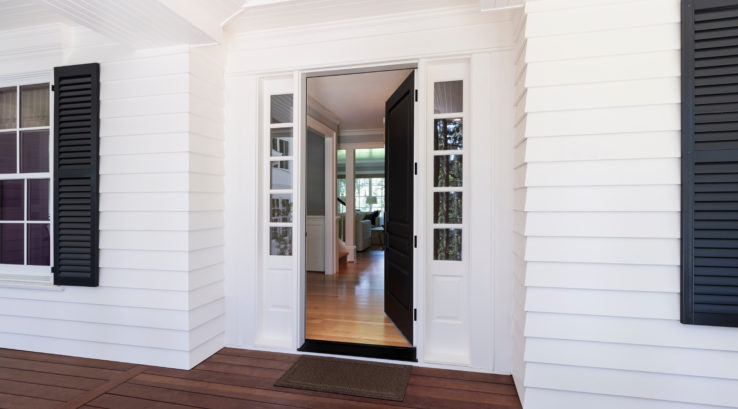Whether you need a new door for functional or decorative purposes, size definitely matters. That’s true for entry doors, internal doors, or, really, any door. While there’s a standard door size, the size you need depends on a variety of factors. Find out more about door sizes — and how to measure yours — to ensure you make the right decision when buying a new door.
Standard Door Sizes
The standard size for a door depends on what type of door you’re talking about. Look around your home. The size of doors leading to interior rooms is likely different from the size of door in your exterior door frames.
Typically, main entry doors measure 36 inches wide by around 80 inches high. Depth can vary depending on material. However, you can have doors that are much taller. These might be visually appealing in home designs with a tall or large entryway or a cathedral ceiling.
Double-entry doors (also called French doors) may not be as wide. There are two of them, and the total exterior door frame would already be wider than with a standard door. You can also have custom entryway doors that have unique dimensions.
Interior doors offer even more standard options, with widths ranging from 18 to 36 inches depending on the use for the door and design of the room in question. You may not need as wide a door for small closet spaces as you would for bedroom or bathroom spaces, where people need to pass.
The Fair Housing Act does call for a minimum of 32-inch widths on both entry and interior door frames meant for people to pass through. This is to accommodate accessibility by a wide range of people and mobility devices. That might be an important figure to keep in mind if you’re planning a new doorway.
How to Measure for a Door
When it’s time to replace a door for any reason, it’s best not to make assumptions. Don’t order a standard door because yours looks normal. Take a few measurements to ensure you’re on the right track when shopping for doors.
The best way to get accurate replacement door measurements is to measure the door that’s already there. Using a tape measure, carefully measure the width, height, and depth of the door.
Measure from the top of the door to the bottom of the door — not from the floor to the top of the door. If you do that, you’ll build the threshold and clearance into the size of your door, which could cause installation problems.
If there’s no door in the entryway yet, you’ll have to take a measurement in the interior or exterior door frame. Door frames aren’t always exactly straight, so take three width measurements. Take one toward the bottom, middle, and top — use the smallest number as the width.
Measure the height in the same way. Take two measurements — one along each side of the door — and use the shorter measurement.
Finally, measure what is called the rebate. This is the groove in the door frame where the door is meant to sit flush when closed. The depth of the rebate is typically the maximum depth of the door you can fit there.
Using these measurements, shop for doors that are closest to — without going over — these numbers. For example, if the height you measured is 80.2 inches, you may want a door that’s 80 inches but not a door that’s 81 inches.
Get Help With a New Door Today
The fit and finish of a new door is important. Doors need to fit so they close properly and easily. Exterior doors must fit flush to reduce drafts and improve the efficiency of heating and cooling in a home.
Does a standard door size exist? Yes, but it’s not necessarily what you need. For help choosing the door that’s ideal for your home and functional needs, contact Thompson Creek.


